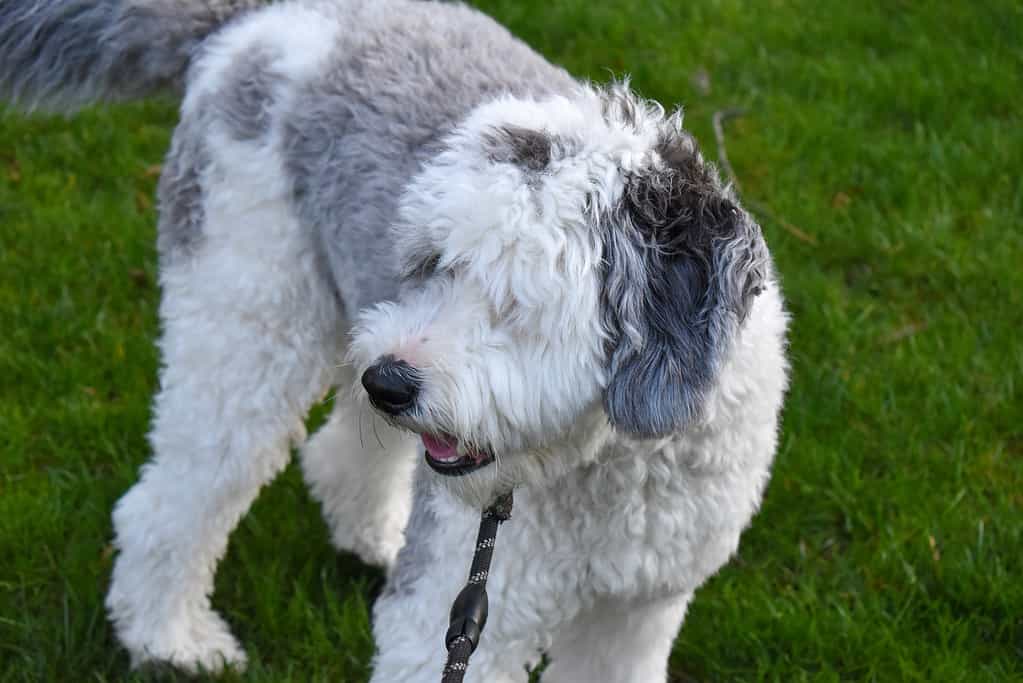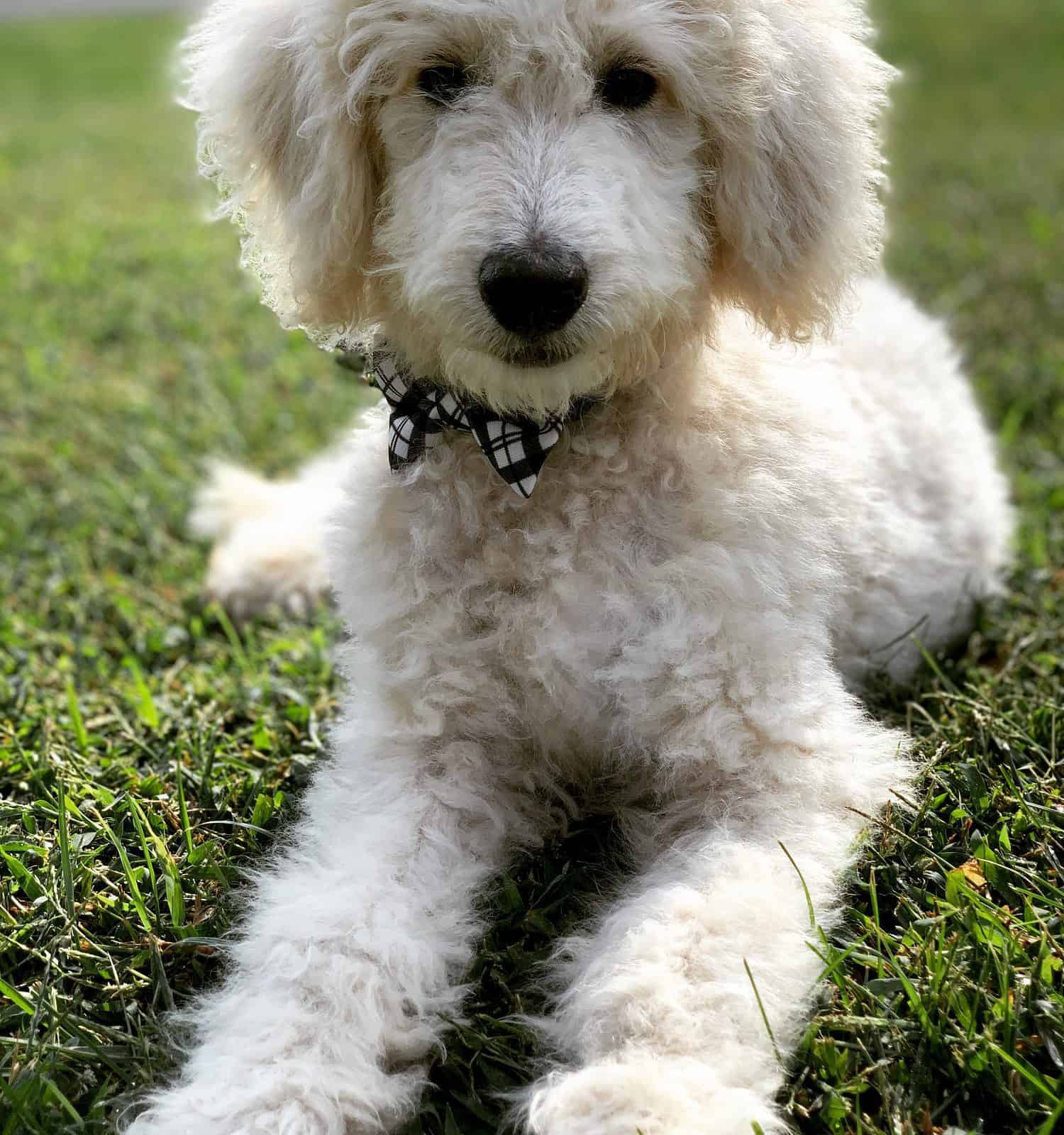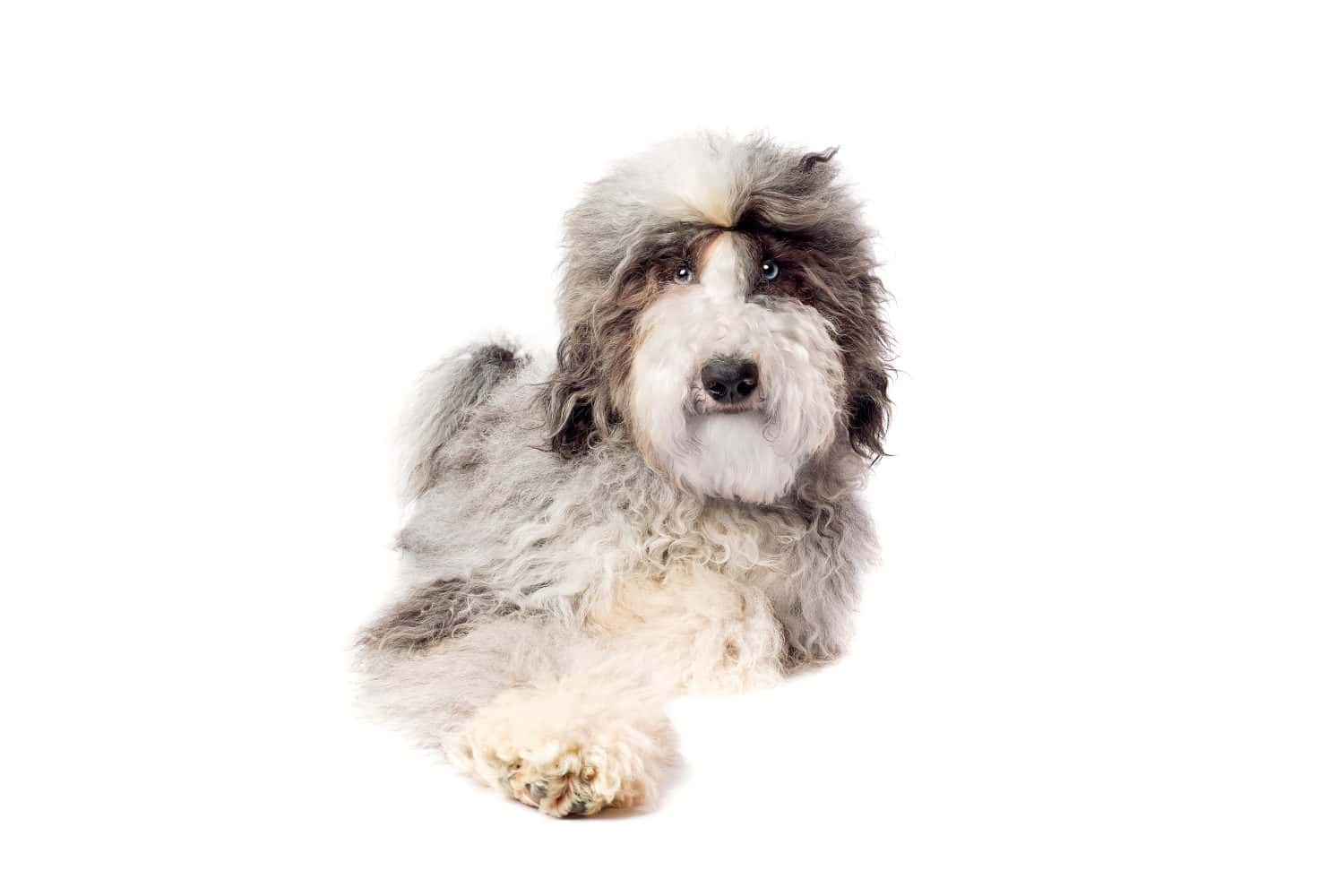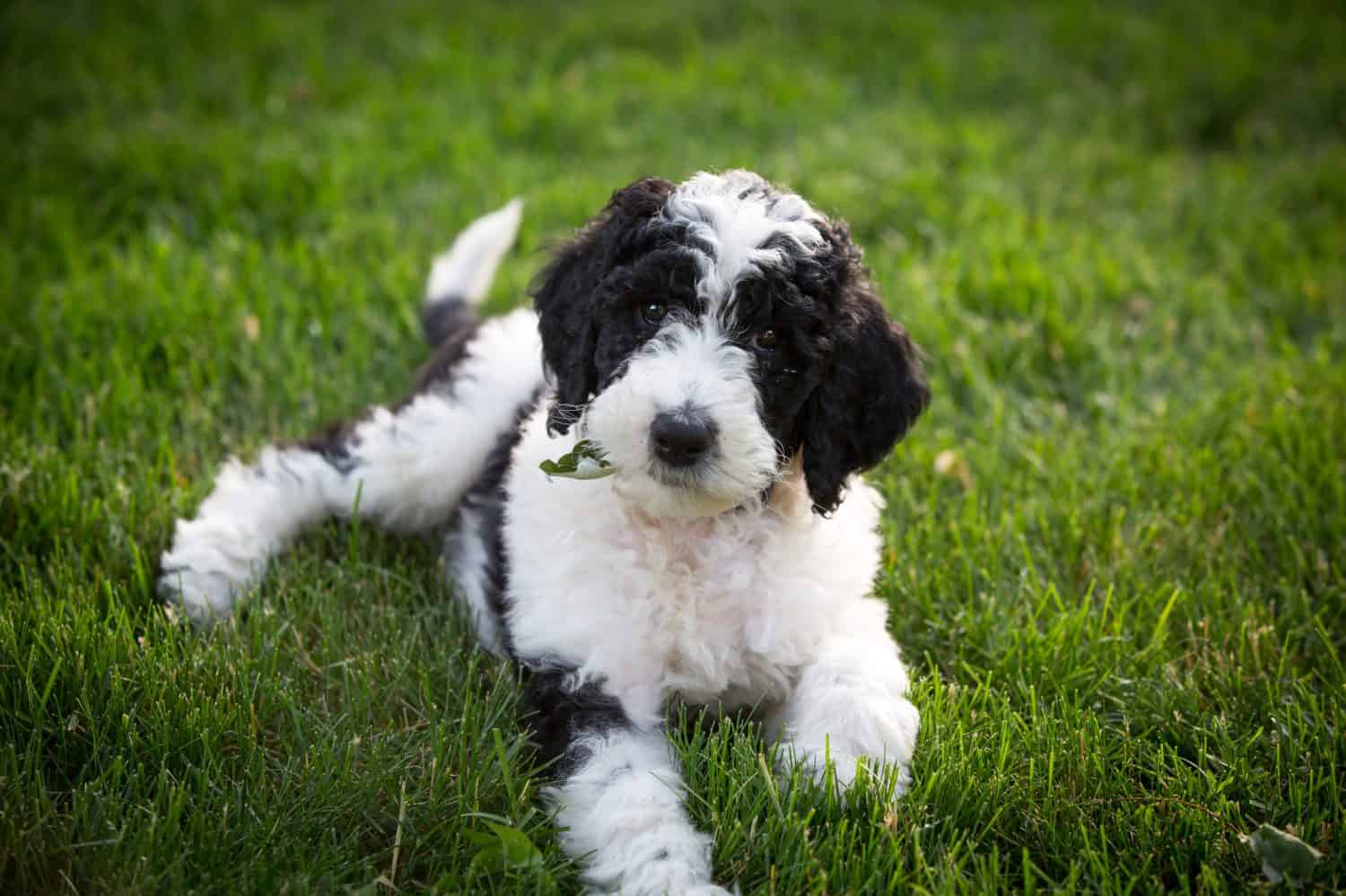When it comes to choosing your next sheepadoodle pup, you’ll want to choose one that’s the right size, coat pattern, and color. Sheepadoodles come in a wide variety of coat colors, some being rare and others more common. If you’re looking to choose the perfect pup, then it’s worth knowing all the amazing colors that a sheepadoodle can have.
Below, we’ll provide a rundown of the rarest to most common coat colors based on genetic factors. So, let’s see all 16 coat colors, from rarest to most common.
#1: Black – Rarest
Amongst sheepadoodle colors, the rarest to breed is a pure black coat. Despite most sheepadoodles having black as a part of their coat color, it’s almost rarely pure black. Mainly, a sheepadoodle inherits its coat color from an Old English sheepdog, which doesn’t have naturally solid black coats. So, it’s very rare for sheepadoodles to have an entirely black coat.
#2: Merle – Rare

The merle gene is linked to genetic illnesses such as deafness and blindness, making it less likely to be bred.
©Lisa Herlick/iStock via Getty Images
Merle coat color is also extremely rare and is a series of solid base colors with patches of multiple colors throughout. Since a sheepadoodle combines Old English sheepdogs and poodles, getting this coat color is extremely difficult, as both breeds don’t normally hold the gene. So, when it does happen, it’s extremely rare. Not only that, but breeders tend to avoid breeding the merle gene because it’s linked to health issues such as deafness and blindness.
#3: Blue Merle – Rare

The blue merle features tri-coloring in shades of gray, blue, silver, or white.
©Logan Swenson/iStock via Getty Images
Despite the rare merle coat color, the more common version is the blue merle. Instead of being produced by a solid base with multiple colors, the blue merle combines blue, gray, and white. The only way to produce this color is through careful genetic testing with at least one of the dogs containing the Merle gene with a white poodle.
#4: Sable – Rare
Sable is one of the rarest coat colors in the sheepadoodle breed. Sable coloring is slightly different from the rest, as the base of the hairs has one color, while the tips are another. Sheepadoodles start with black hair and develop different sable-colored tips as they age.
The sable color is specifically tied to a gene known to cause fading. Sheepadoodle puppies with black-tipped hairs may grow out of them as they age.
#5: Brown – Rare
Another common fur color in sheepadoodles is brown, common in Old English sheepdogs and poodles. Brown-colored fur looks like milk or dark chocolate and is often rich in color. At times, sheepadoodles may have multiple shades of brown throughout their fur. Depending on genetics, they may also have black, white, or even cream patches inside their coats.
Typically, brown-coated sheepadoodles have either bi-color or tri-color patterns. So, it’s common to see two or more main coat colors. However, the base color is almost always white. There is a pure brown sheepadoodle coat color, but it’s extremely uncommon.
#6: Red – Rare
Red sheepadoodle fur coloring is rare, especially given its rarity in both poodles and Old English sheepdogs. Breeders must ensure the poodle has a red coat when breeding for this specific coat color. Otherwise, the offspring will not have any red coating in their genetics.
The vibrant red coat can also have other color patches throughout the body. It is usually cream or white fur on the face, neck, paws, and chest. Similar to other coat colors, the red fur may lighten with age.
#7: White – Uncommon

White sheepadoodles often have a pure white base coat with no other coloring.
©jlw78000/Shutterstock.com
A white sheepadoodle features a pure white coat and is very uncommon. Usually, a sheepadoodle will have some sort of colored patches. However, pure white doesn’t have any other coloring besides white. It’s difficult to ensure that the genetics will produce a solid white coat. In addition, some sheepadoodles may seem solid white until they age and develop different coloring.
#8: Grizzle – Uncommon

Grizzle coat colors don’t have any set pattern or color.
©Erik Lam/Shutterstock.com
Another uncommon coat color is the Grizzle sheepadoodle. A grizzle fur color has no pattern and includes a mixture of multiple colors. Instead of having a distinctive base or patches, the fur is randomly colored and lacks patterns. Grizzle sheepadoodles will mostly have brown, tan, black, white, or grey fur.
#9: Fawn – Uncommon
Fawn sheepadoodles get the name due to their coat color resembling an actual fawn. The tone of their fur is somewhere between red and brown but lighter than the pure coat colors. Many dogs with this fur color end up having patches of white alongside their face and body. However, the base color is always fawn.
#10: Silver – Uncommon
Commonly mistaken for gray sheepadoodles, silver coats are also a typical fur color. Unlike gray, silver is much lighter in coloring and can have bi-color or tuxedo patterns. In addition, the fur may also include white patching alongside the chest and paws. Similar to the blue coat color, silver tends to be dark at birth and gradually becomes lighter as the dog ages.
#11: Blue – Uncommon
Similar to the blue merle, the blue sheepadoodle has solid blue coloring. The fur color is a mixture of gray and silver but with more blue and tint. Appearance-wise, the blue sheepadoodle has patches of lighter and darker fur all over its body. However, the dog may also have black, gray, silver, and white fur patches. With time, the fur color will become lighter and have a blue tint as the dog ages.
#12: Gray – Common

Gray coats can either be solid or include patches of white.
©Kandji/Shutterstock.com
A common coat color is gray, as the coloring is unique to Old English shepherds and poodles. Gray sheepadoodles will have a gray coat and white patching on their muzzle, neck, chest, and paws. Depending on the parent dog’s genetics, sheepadoodles may also have blue, silver, and black tones.
#13: Black and White – Common

The black and white coat color is generally inherited from the Old English sheepdog.
©Lisa Mounteer/Shutterstock.com
A more common coat color for sheepadoodles is black and white, which is also called parti or tuxedo. Mostly inherited by the Old English sheepdog, their genetics produce either a solid white color with black patches or vice versa. However, the most common is a white body with black patches. Sometimes, a black and white coat changes shade when the dog ages. This results in the fur becoming lighter gray, blue, or silver.
#14: Cream – Common

Cream coloring often includes white patches all over the body.
©karlamarie6/iStock via Getty Images
A cream-colored sheepadoodle features lovely cream fur that is somewhat a mix of brown and white. The coat color will also include white patches on their body and face, mainly on the paws, chest, and muzzle. While the cream color tends to stay consistent throughout puppyhood, the coating could change to become more vibrant with brown, red, or fawn coloring.
#15: Bi-Color – Common

Bi-coloring is a combination of two colors.
©Lisa Mounteer/Shutterstock.com
Bi-color sheepadoodles have a combination of two coat colors. Often, this is a combination of black and white. However, depending on the parents, it can also be gray, white, and more. This coloring shouldn’t be confused with the black and white sheepadoodle.
#16: Tri-Color – Common

Tri-coloring features three different coat colors.
©Annette Shaff/Shutterstock.com
Tri-color sheepadoodles are multi-colored dogs that mainly have three fur colors. Sheepadoodles tend to have a mixture of brown, black, or white. The black coloring is often the dominant coat color, but sometimes it can be brown, depending on the parents.
Summary of Sheepadoodle Colors from Rarest to Most Common
| Rank | Color | Rarity |
|---|---|---|
| #1 | Black | Rarest |
| #2 | Merle | Rare |
| #3 | Blue Merle | Rare |
| #4 | Sable | Rare |
| #5 | Brown | Rare |
| #6 | Red | Uncommon |
| #7 | White | Uncommon |
| #8 | Grizzle | Uncommon |
| #9 | Fawn | Uncommon |
| #10 | Silver | Uncommon |
| #11 | Blue | Uncommon |
| #12 | Gray | Common |
| #13 | Black and White | Common |
| #14 | Cream | Common |
| #15 | Bi-Color | Common |
| #16 | Tri-Color | Common |
The photo featured at the top of this post is © Logan Swenson/Shutterstock.com
Ready to discover the top 10 cutest dog breeds in the entire world?
How about the fastest dogs, the largest dogs and those that are -- quite frankly -- just the kindest dogs on the planet? Each day, AZ Animals sends out lists just like this to our thousands of email subscribers. And the best part? It's FREE. Join today by entering your email below.
Thank you for reading! Have some feedback for us? Contact the AZ Animals editorial team.






